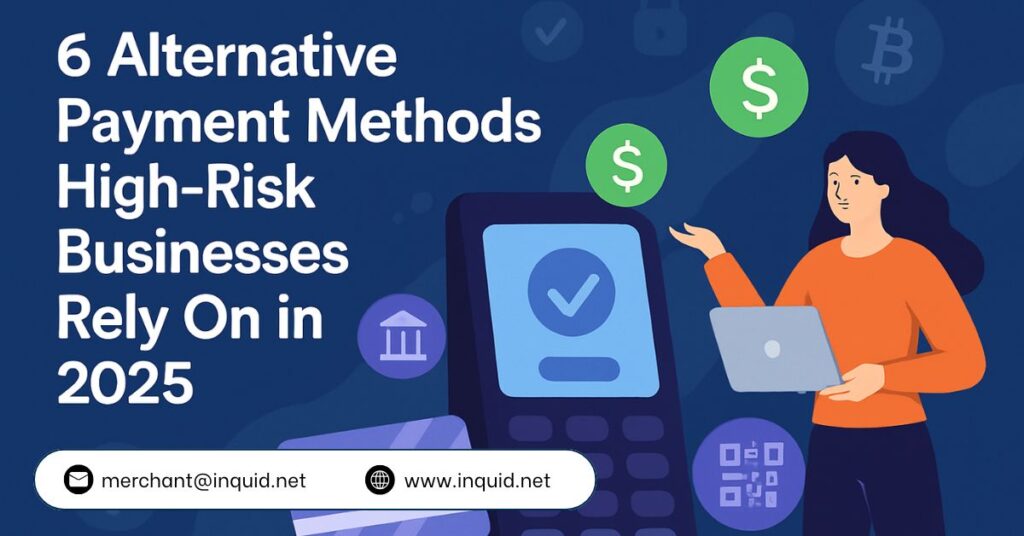
Running a business that deals with high chargeback rates, regulatory oversight, or niche content restrictions often means getting turned down by traditional payment processors. This is why many high-risk operators are shifting away from conventional credit card options and turning to alternative payment methods (APMs) that offer more flexibility, privacy, and acceptance.
Here are six APMs that high-risk businesses are increasingly using in 2025 to keep transactions moving and customers coming back.
1. Cryptocurrency Payments
For industries like adult content, gaming, and cross-border forex, crypto is more than a trend. It’s often the only reliable option when cards get declined or banks raise questions.
Digital currencies such as Bitcoin, Ethereum, and stablecoins provide faster settlement, lower fees, and less scrutiny from legacy institutions. For many merchants, this means fewer frozen payouts and greater transaction stability.
To integrate crypto payments securely with risk controls in place, using the right alternative payment method provider is key.
2. E-wallets (Like Skrill, Neteller, ecoPayz)
E-wallets have seen massive growth in high-risk industries. Customers like them for speed and privacy, while businesses benefit from higher acceptance rates—especially in regions where credit cards are frequently declined.
Forex platforms and online casinos often support multiple wallets to cover various user bases. The ability to handle instant deposits and same-day withdrawals makes them especially attractive.
For high-risk sectors aiming to offer flexible options across borders, inquid helps set up the right mix of e-wallet partners based on your region and industry.
3. Bank Transfers and Open Banking
For regulated markets, direct bank transfers provide a compliant and secure method. With open banking gaining traction in Europe and parts of Asia, this method allows real-time payments without needing card networks.
This is particularly useful for forex trading sites and legal betting operations, where settlement speed and traceability are both necessary. It’s also becoming a preferred method in regions where card penetration is low.
Using bank-based APMs also reduces dependency on acquiring banks that often flag high-risk MCCs.
4. Prepaid Cards and Vouchers
Many high-risk platforms—especially those in adult, gaming, and IPTV—now support prepaid cards and vouchers like Paysafecard. These let users pay anonymously and with fixed value, minimizing fraud and reducing the risk of overcharging disputes.
From a business standpoint, this method offers a clear edge: fewer chargebacks and minimal KYC barriers. While it doesn’t fully replace recurring billing, it supports initial customer acquisition well.
To stay compliant while offering this method, it’s smart to work with processors who understand both the product and its regulatory limits.
5. Mobile Payment Apps (UPI, M-Pesa, Paytm, etc.)
In Asia, Africa, and parts of the Middle East, mobile payments have outpaced cards. High-risk platforms expanding into these markets are adapting by offering region-specific APMs like UPI in India or M-Pesa in Kenya.
These methods often bypass traditional gateways entirely and tap into mobile money ecosystems, allowing direct transfers from user wallets to business accounts.
If you’re looking to scale in emerging markets, having APMs for international business is no longer optional—it’s expected.
6. Localized APMs for LATAM, EU, and SEA
High-risk operators expanding globally must adapt to regional preferences. In Europe, SOFORT and Giropay are widely used. In Latin America, options like Boleto Bancário in Brazil or SPEI in Mexico help businesses reach more users.
Gaming and adult platforms benefit from integrating region-specific APMs not just for higher conversions, but for regulatory compliance. One method doesn’t work everywhere—localized support matters.
A partner like inquid can help evaluate and onboard these APMs based on your traffic sources, volumes, and approval requirements.
FAQs About Alternative Payment Methods for High-Risk Businesses
What are alternative payment methods?
Alternative payment methods (APMs) are non-traditional ways of accepting payments, such as e-wallets, crypto, bank transfers, mobile money, or vouchers. These options are especially useful for high-risk businesses that face issues with regular credit card processing.
Why do high-risk businesses need APMs?
Traditional processors often reject high-risk industries due to chargebacks, content type, or regulations. APMs offer flexible and often more reliable options to receive payments without disruptions.
Are APMs safer than credit cards?
APMs like e-wallets and crypto often have lower fraud rates and fewer chargebacks compared to cards. They also offer privacy, speed, and better regional compatibility.
Can I use multiple APMs on one platform?
Yes. In fact, it’s recommended. Offering multiple APMs helps improve approval rates, supports more geographies, and gives users more payment flexibility.
Which APM is best for adult or gaming platforms?
E-wallets, crypto, and prepaid vouchers work well for adult and gaming platforms. These methods help reduce declines and allow for more discreet, user-friendly transactions.
Where can I get help setting up APMs for my business?
You can contact us for expert help in setting up APMs designed for your high-risk industry and target regions.
